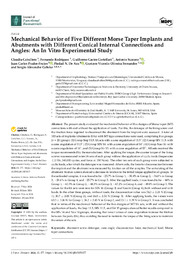Please use this identifier to cite or link to this item:
https://hdl.handle.net/11000/32415Full metadata record
| DC Field | Value | Language |
|---|---|---|
| dc.contributor.author | Caballero, Claudia | - |
| dc.contributor.author | Rodriguez, Fernando | - |
| dc.contributor.author | Castro Cortellari, Guillermo | - |
| dc.contributor.author | Scarano, Antonio | - |
| dc.contributor.author | Prados-Frutos, Juan Carlos | - |
| dc.contributor.author | De Aza, Piedad | - |
| dc.contributor.author | Oliveira Fernandes, Gustavo Vicentis | - |
| dc.contributor.author | Gehrke, Sergio Alexandre | - |
| dc.contributor.other | Departamentos de la UMH::Ciencia de Materiales, Óptica y Tecnología Electrónica | es_ES |
| dc.date.accessioned | 2024-07-03T07:15:15Z | - |
| dc.date.available | 2024-07-03T07:15:15Z | - |
| dc.date.created | 2024 | - |
| dc.identifier.citation | Journal of Functional Biomaterials, 2024, 15, 177. | es_ES |
| dc.identifier.issn | 2079-4983 | - |
| dc.identifier.uri | https://hdl.handle.net/11000/32415 | - |
| dc.description.abstract | The present study evaluated the mechanical behavior of five designs of Morse taper (MT) connections with and without the application of loads. For this, the detorque of the fixing screw and the traction force required to disconnect the abutment from the implant were assessed. A total of 100 sets of implants/abutments (IAs) with MT-type connections were used, comprising five groups (n = 20/group): (1) Group Imp 11.5: IA sets with a cone angulation of 11.5◦ ; (2) Group SIN 11.5: with a cone angulation of 11.5◦ ; (3) Group SIN 16: with a cone angulation of 16◦ ; (4) Group Neo 16: with a cone angulation of 16◦ ; and (5) Group Str 15: with a cone angulation of 15◦ . All sets received the torque recommended by the manufacturer. After applying the torque, the counter torque of the fixing screws was measured in ten IA sets of each group without the application of cyclic loads (frequencies ≤ 2 Hz, 360,000 cycles, and force at 150 Ncm). The other ten sets of each group were subjected to cyclic loads, after which the detorque was measured. Afterwards, the force for disconnection between the implant and the abutment was measured by traction on all the samples. The untwisting of the abutment fixation screws showed a decrease in relation to the initial torque applied in all groups. In the unloaded samples, it was found to be −25.7% in Group 1, −30.4% in Group 2, −36.8% in Group 3, −29.6% in Group 4, and −25.7% in Group 5. After the applied loads, it was found to be −44% in Group 1, −43.5% in Group 2, −48.5% in Group 3, −47.2% in Group 4, and −49.8% in Group 5. The values for the IA sets were zero for SIN 16 (Group 3) and Neo16 (Group 4), both without and with loads. In the other three groups, without loads, the disconnection value was 56.3 ± 2.21 N (Group 1), 30.7 ± 2.00 N (Group 2), and 26.0 ± 2.52 N (Group 5). After applying loads, the values were 63.5 ± 3.06 N for Group 1, 34.2 ± 2.45 N in Group 2, and 23.1 ± 1.29 N in Group 5. It was concluded that in terms of the mechanical behavior of the five designs of MT IA sets, with and without the application of loads, the Imp 11.5, SIN 11.5, and Srt 15 groups showed better results compared to the SIN 16 and Neo 16 groups, showing that lower values of cone angulation increase the friction between the parts (IA), thus avoiding the need to maintain the torque of the fixing screw to maintain the union of the sets. | es_ES |
| dc.format | application/pdf | es_ES |
| dc.format.extent | 11 | es_ES |
| dc.language.iso | eng | es_ES |
| dc.publisher | MDPI | es_ES |
| dc.rights | info:eu-repo/semantics/openAccess | es_ES |
| dc.rights | Attribution-NonCommercial-NoDerivatives 4.0 Internacional | * |
| dc.rights.uri | http://creativecommons.org/licenses/by-nc-nd/4.0/ | * |
| dc.subject | abutment screw detorque | es_ES |
| dc.subject | cone angle | es_ES |
| dc.subject | disconnection force | es_ES |
| dc.subject | mechanical load | es_ES |
| dc.subject | Morse taper connections | es_ES |
| dc.subject.other | CDU::6 - Ciencias aplicadas::62 - Ingeniería. Tecnología | es_ES |
| dc.title | Mechanical Behavior of Five Different Morse Taper Implants and Abutments with Different Conical Internal Connections and Angles: An In Vitro Experimental Study | es_ES |
| dc.type | info:eu-repo/semantics/article | es_ES |
| dc.relation.publisherversion | https://doi.org/10.3390/jfb15070177 | es_ES |

View/Open:
2024-jfb-15-00177 SergioG.pdf
2,06 MB
Adobe PDF
Share:
.png)
